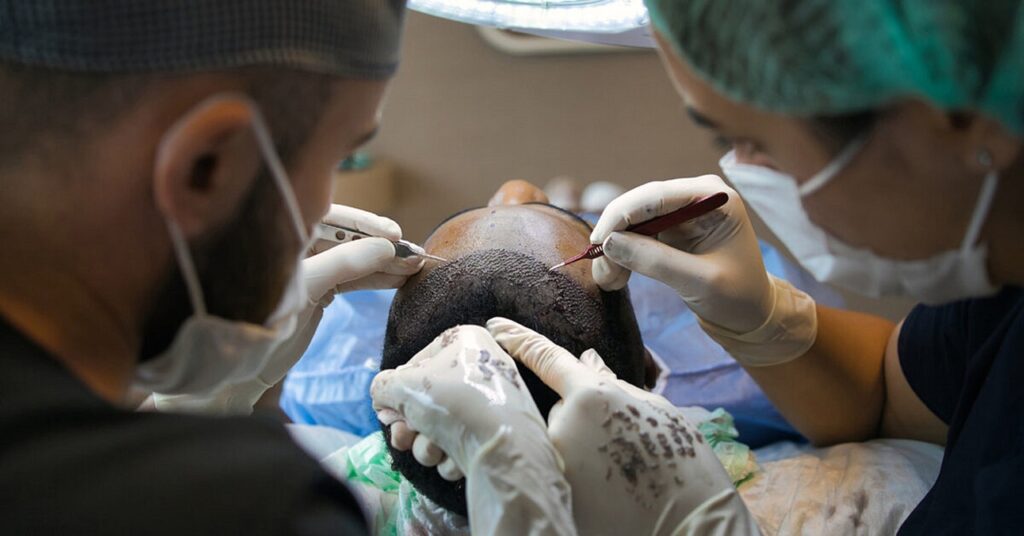As a physician who specializes in hair transplants, I cannot emphasize enough how important it is to get enough rest and recover after undergoing this treatment. In order for your body to repair and renew, it needs time, and sleep is an essential component of this process. This thorough guide will give you all the information you need to know about how to sleep after a hair transplant, including the dos and don’ts, the optimum sleeping positions, and recommendations for better sleep during the recovery phase. I will also provide you with information about how to sleep properly after a hair transplant. The next step is to make sure that you obtain the greatest possible outcomes from your hair transplant, so let’s get started.
The Importance of Rest and Recovery After a Hair Transplant
Each and every surgical treatment, including a hair transplant, requires a significant amount of rest and recuperation in order to be successful. Immediately following the surgical procedure, your body will go through a period of recuperation, during which time new hair follicles will begin to sprout. This procedure demands a significant amount of energy and resources, which is why it is essential to have sufficient rest and sleep of high quality.
During the time that you are asleep, your body functions to repair and revitalize itself. For the purpose of facilitating the repair and regeneration of tissues, the growth hormone is secreted during the deepest stages of sleep. It is important to make sure that you get enough sleep after getting a hair transplant so that your body has the best possible opportunity of recovering quickly and achieving the finest possible results from the treatment.
How to Sleep After a Hair Transplant: Dos and Don’ts
Following the completion of a hair transplant, it is imperative to adhere to specific rules in order to facilitate the healing process and reduce the likelihood of any potential issues. In terms of sleeping after a hair transplant, the following are some things that you should and should not do:
Do:
- Sleep with your head elevated: Sleeping with your head elevated helps minimize edema and improves blood circulation to the scalp. Sleeping with your head elevated also offers other benefits. Making use of a neck cushion or propping up your head with additional pillows are both viable options for accomplishing this goal.
- Utilize a neck cushion: A neck pillow offers support and prevents any direct pressure from being exerted on the hair follicles that have recently undergone hair transplantation. During the time that you are sleeping, it assists in preserving the correct alignment of your head and neck.
- You should sleep on your back: If you want to avoid putting any excessive pressure on the area that has been transplanted, the best posture to sleep in is on your back. Maintaining the proper alignment of your head, neck, and spine is another benefit of this practice.
Don’t:
- Sleep on your stomach or on your sides: Sleeping on your stomach or on your sides can impose pressure on the area that has been transplanted, which can result in the grafts becoming dislodged or in potential harm to the hair follicles that have recently been implanted.
- It is important to avoid making any rapid or violent movements when adjusting your pillows. Avoid using excessive force when adjusting your pillows. Movements that are gentle are required in order to avoid putting any tension on the scalp or the grafts.

How Long to Sleep With a Neck Pillow After a Hair Transplant
It is strongly recommended that you use a neck pillow after getting a hair transplant in order to provide support and to ensure that your head and neck remain in the correct alignment, respectively. It helps to avoid any direct pressure being applied to the area that has been transplanted and ensures that the scalp has the best possible blood circulation. However, for how long should you continue to use a cushion for your neck? The length of time varies depending on the healing process as well as the specific circumstances of each individual.
After receiving a hair transplant, it is recommended that you continue to use a neck pillow for a period of at least two weeks. The freshly transplanted hair follicles are fragile and prone to damage during this initial period of time after the procedure. Utilizing a neck cushion is a great way to safeguard the grafts and increase the likelihood of a good outcome.
On the other hand, it is absolutely necessary to confer with your hair transplant surgeon in order to receive individualized guidance. They will evaluate your progress and decide the most effective length of time for you to use a neck pillow based on the condition that you are currently experiencing.
Sleeping Positions and Hair Transplant Success
One of the most important factors in determining whether or not your hair transplant will be successful is the posture in which you sleep. For the purpose of facilitating appropriate healing and minimizing the risk of any potential problems, the following sleeping postures are recommended:
- Sleeping on your back: If you have recently undergone a hair transplant, the best posture to sleep in is on your back. In addition to minimizing any pressure that may be exerted on the transplanted area, it enables an even distribution of weight. Additionally, it assists in the maintenance of the alignment of your head, neck, and spine, which in turn ensures that the scalp receives the best possible blood circulation.
- Sleeping on your side: If you find that sleeping on your back is too uncomfortable for you, you might choose to sleep on your side instead. On the other hand, it is of the utmost importance to avoid letting the transplanted area come into direct contact with the cushion. It is important to prevent any friction or pressure from being applied to the grafts, therefore, place a clean, soft cloth or towel between your head and the pillow.
- Sleeping on your stomach: After a hair transplant, it is not recommended that you sleep anywhere other than on your stomach. The transplanted area is subjected to a substantial amount of pressure, which raises the possibility that the grafts will become dislodged. It is recommended that you stay away from this position throughout the early phase of recuperation.
How to Sleep After a Crown Hair Transplant
A crown hair transplant requires special care and attention when it comes to sleeping positions. The crown area is located at the back of your head, and finding the right sleeping position can be challenging. Here are some tips on how to sleep after a crown hair transplant:
- Sleeping on your back: If you have recently undergone a hair transplant, the best posture to sleep in is on your back. In addition to minimizing any pressure that may be exerted on the transplanted area, it enables an even distribution of weight. Additionally, it assists in the maintenance of the alignment of your head, neck, and spine, which in turn ensures that the scalp receives the best possible blood circulation.
- Sleeping on your side: If you find that sleeping on your back is too uncomfortable for you, you might choose to sleep on your side instead. On the other hand, it is of the utmost importance to avoid letting the transplanted area come into direct contact with the cushion. It is important to prevent any friction or pressure from being applied to the grafts, therefore, place a clean, soft cloth or towel between your head and the pillow.
- Sleeping on your stomach: After a hair transplant, it is not recommended that you sleep anywhere other than on your stomach. The transplanted area is subjected to a substantial amount of pressure, which raises the possibility that the grafts will become dislodged. It is recommended that you stay away from this position throughout the early phase of recuperation.
Sleeping Upright After a Hair Transplant: How Long is Necessary?
After a hair transplant, it is commonly recommended that the patient sleep in an upright position in order to reduce swelling and ensure that the scalp receives adequate blood circulation. But for how long should you remain in an upright position while you sleep? The complexity of the technique determines the amount of time needed, which varies from person to person.
After a hair transplant, it is recommended that you sleep in an upright position for the first several nights after the procedure. This not only helps minimize swelling but also allows fluid to drain away from the scalp, which speeds up the healing process. On the other hand, sleeping in an upright position for an extended period of time might be a source of discomfort and may not be required for everyone.
It is absolutely necessary to adhere to the suggestions that your hair transplant surgeon brings to your attention. Based on your unique circumstances, they will evaluate your progress and provide you with recommendations for the ideal amount of time to spend sleeping in an upright position. After the swelling has subsided and the healing process has advanced, you will be able to gradually convert to a sleeping posture that is more pleasant for you.
Tips for Better Sleep During the Hair Transplant Recovery Period
When it comes to a smooth recovery following a hair transplant, getting a good night’s sleep is absolutely necessary. During the period of recuperation, the following are some suggestions that may assist you in sleeping comfortably and will encourage greater healing:
- Create a relaxing sleep environment: Make certain that your bedroom is calm, dark, and at a temperature that is pleasant for you. In order to establish a peaceful atmosphere for sleeping, it may be required to make use of blackout curtains, earplugs, or white noise machines.
- Establishing a regular sleep routine involves going to bed and waking up at the same time every day. This will help you get into the habit of getting enough rest. Both the quality of your sleep and the regulation of your body’s internal clock are improved as a result of this.
- Avoid using electronic devices in the hours before bedtime because the blue light they emit might interfere with your sleep. In order to give your body the opportunity to wind down, you should refrain from using electronic devices such as phones, tablets, or computers for at least one hour before going to bed.
- Relaxation techniques should be practiced: Before going to bed, you should engage in relaxation techniques such as deep breathing exercises, meditation, or mild stretching. You may prepare your body and mind for a good night’s sleep by engaging in these activities, which help relax your mind.
- Utilize bedding that is comfortable: Make an investment in a mattress, pillows, and bedding that are of excellent quality and provide sufficient support and comfort. Having this done will put you in the best possible position to have a restful night’s sleep.
How to Sleep Comfortably After a Hair Transplant FUE Procedure
The Follicular Unit Extraction (FUE) process for hair transplantation involves the removal of individual hair follicles from the donor area and the subsequent transplanting of those hair follicles to the recipient area. After undergoing a FUE surgery, it is imperative to adhere to particular rules in order to provide a comfortable sleep and the best possible recovery. Follow these steps to ensure a restful night’s sleep following a FUE hair transplant procedure:
- Sleep with your head elevated: A reduction in edema and an improvement in blood circulation to the scalp are also benefits of sleeping with your head elevated. In order to keep your head, neck, and spine in the correct posture, you should prop up your head using a neck pillow or more cushions.
- Direct pressure should be avoided in the area that has been transplanted. While you are sleeping, you should make sure that the transplanted area is not subjected to any direct pressure. If you want to provide cushioning and prevent any friction or pressure from being applied to the grafts, you should either use a neck pillow or insert a soft, clean cloth or towel between your head and the pillow.
- After a hair transplant FUE treatment, the most appropriate position for you to sleep in is on your back. It is important to always follow the prescribed sleeping positions. In addition to minimizing any pressure that may be exerted on the transplanted area, it enables an even distribution of weight. Try sleeping on your side instead of your back if you find that sleeping on your back is difficult. However, make sure that the area that has been transplanted does not come into direct contact with the pillow.
Common Sleep-Related Concerns After a Hair Transplant and How to Address Them
There is a possibility that you will encounter specific sleep-related difficulties throughout the period of recovery following a hair transplant. In order to address some of the most common issues, here are some examples:
- Discomfort or pain: After a hair transplant, it is not uncommon for the recipient to experience some discomfort or agony. You should take any prescribed painkillers before bed as your surgeon advises in order to ease any discomfort and encourage better sleep.
- Itching or tingling: Patients frequently experienced itching or tingling feelings during the healing phase. Scratching or touching the area that has been transplanted should be avoided because it can cause harm to the graft. If the itching becomes intolerable, you should seek the advice of your surgeon regarding the proper treatments.
- Anxiety or stress: It is normal to experience feelings of anxiety or stress during the period necessary for recuperation. Before going to bed, you should engage in activities that help you relax, such as meditation or deep breathing exercises, in order to settle your mind and improve the quality of your sleep.
- Discomfort caused by sleeping posture: If you find it difficult to maintain a particular sleeping position, you might find it helpful to use additional pillows or cushions for support. To determine which sleeping position is most comfortable for you, you should try out a variety of different positions.
Conclusion: The Role of Rest and Recovery in Maximizing Hair Transplant Results
In conclusion, getting enough rest and recovering properly are two of the most important parts of getting the most out of a hair transplant. In order for your body to repair and rejuvenate, it is crucial that you get enough sleep. This will ultimately allow the newly transplanted hair follicles to grow more successfully. You may ensure a smooth recovery and obtain the best possible outcome by following the dos and don’ts of sleeping after a hair transplant, utilizing a neck pillow, and adopting the suggested sleeping positions. These are all things that you should do.
Keep in mind that the healing process might differ from person to person, which is why it is essential to consult with your hair transplant surgeon in order to receive individualized guidance and recommendations. You can count on Sule Hair Clinic to be there for you every step of the way, providing you with the highest possible level of aftercare hair transplant competence. Consequently, make relaxation and recuperation your top priorities, and take pleasure in the life-altering experience that a hair transplant might bring about.
To learn more about hair transplants and schedule a consultation, visit Sule Hair Clinic.





